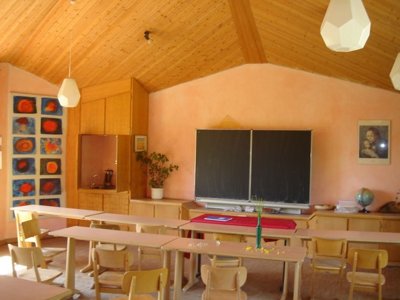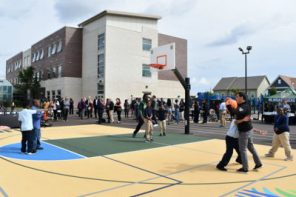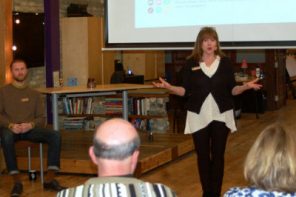Waldorf eduction is an approach to learning based on the philosophies of Austrian philosopher Rudolph Steiner. There is one Waldorf school in Milwaukee, Tamarack Waldorf School, 1150 E. Brady St., and another in Pewaukee, Prairie Hill Waldorf School. Both schools go through eighth grade, but at this point, there is not a Waldorf high school in the Milwaukee area.
Waldorf education follows Steiner’s theories of childhood development. Hence, from pre-school until the age of 6 or 7, kids are given extensive amounts of time for free play, imagination growth and self discovery in a classroom that is often similar to a home setting. Children spend a lot of time outdoors learning to be attentive to and appreciative of nature. Toys are generally made from natural, simple materials like cloth and wood. They are not taught to read until later.
From about age 7 to about 14, Waldorf kids attend elementary school, which centers around an arts-based curriculum that includes visual arts, drama, artistic movement (eurythmy), vocal and instrumental music and crafts. During this period they often learn German and either Spanish or French.
In most Waldorf schools, kids enter secondary education when they are about 14 years old. Secondary education is provided by specialist teachers for each subject which are more academic in nature.
Riverwest’s Melissa Hansen has three daughters enrolled at Tamarack Waldorf School.
“Waldorf focuses heavily on the whole child, using art and handwork to help develop their brains. I liked that the kindergartens are all play-based, and they learn from doing,” says Hansen. “I was skeptical when my daughter was in second grade and couldn’t read yet, but now she reads 500-page books in a few days.”
The first Waldorf school was founded in 1919 to serve the children of employees at the Waldorf-Astoria cigarette factory in Stuttgart, Germany. As of 2011 there were 998 independent Waldorf schools located in 60 countries throughout the world.
Nancy Price is a grade school class teacher at Tamarack and in her second cycle of teaching kids from grades one through eight. We recently caught up with Price to find out more about Waldorf education.
“I am happy to say that my job is also my vocation and my passion,” says Price.
OnMilwaukee.com: How does Waldorf differ from “traditional” school in the U.S.?
Nancy Price: Tamarack Waldorf School is a private independent school that participates in the Milwaukee Parental School Choice Program. Our program is one that focuses attention on creating balance in all areas of our children’s experience, including the academic and artistic subjects they learn, their social interactions, their ability to achieve inner flexibility, harmony, and joy, and their participation in a robust and healthy lifestyle.
The unique curriculum of Waldorf schools around the world all spring from its founder, Rudolf Steiner’s, insightful view of child development. While at the Tamarack Waldorf School, a student will typically have the same teacher for all main subjects from the first through the eighth grade.
This approach allows a teacher to observe the profound process of growth and development in each student through those years and provides the opportunity for a deep and special bond to form between the student and their class teacher, often lasting long after students have graduated from our school.
OMC: What are valuable lessons kids get from a Waldorf education?
NP: Waldorf Education provides students with an artistic, creative and well-rounded curriculum that engages children with stories and lively teacher presentations on such things as math, science, history and ancient cultures on a daily basis. Students learn to become inwardly flexible, improve their capacity for social interaction, and become independent and self-motivated learners by the time they reach high school.
OMC: What is Waldorf’s stance on teaching / using technology?
NP: We like to teach children how to use books to research information, how to write summaries from teacher presentations and how to relate to other human beings face to face. We also like to teach children how the world works, and do so in a specific time sequence that relates to a student’s phase of human development.
In the older grades, after we study the Industrial Revolution, and how machines changed the work of humankind forever, we might move gradually to the technological revolution, with which the students are intimately familiar. In learning how cell and computer technology operates, they have a deep understanding for the human ingenuity and genius that created such inventions. This knowledge leaves them with a new appreciation of some of the every day items most of us take for granted.
Once students have an understanding of how the technology functions, they can be educated about how to find reliable information on the Internet, how to take pictures with digital cameras and how to create newsletters and other projects on the computer. We also emphasize how important it is that human beings learn to use technology rather than having technology use human beings.
Along with a vast array of artistic and musical works, Tamarack students have presented eighth grade graduation projects including such things as documentary films, a working hover craft built from scratch and a small working car built by hand. Technology, when brought at the right time and used in service of the world, is a valuable part of student development.
OMC: Is there a particular kind of child that’s a good fit in a Waldorf setting? A particular kind of kid that’s not?
NP: Children whose parents are informed about and in agreement with the philosophy of the school do best because appreciative parents support the work of the classroom in their home environment and support the teacher in what must be done during the school day. All children become engaged and enthusiastic learners once they spend some time attending a Waldorf school.
OMC: Is spirituality a part of Waldorf?
NP: Waldorf education teaches children reverence for all of life. Through our developmental curriculum, teachers present living pictures of the processes of nature, life and death, and archetypal experience.
While no religion is taught at the Waldorf school, we encourage children to notice the sacred world of the unseen, which might manifest in science lessons perhaps related to electricity or the power of the wind, in math lessons in relation to the beauty and elegance of the number world, and certainly in the social bonds between classmates, teachers, and family members.
While these forces cannot be seen, they are quite real, and such lessons suggest to students that not everything in existence can be seen with the eyes. Children are expected to respect themselves and others and this encompasses the diversity of spiritual and religious traditions that abound at Tamarack.


 i evaluate to yes even if there's no image
i evaluate to yes even if there's no image  i evaluate to yes even if there's no image
i evaluate to yes even if there's no image  i evaluate to yes even if there's no image
i evaluate to yes even if there's no image  i evaluate to yes even if there's no image
i evaluate to yes even if there's no image  i evaluate to yes even if there's no image
i evaluate to yes even if there's no image  i evaluate to yes even if there's no image
i evaluate to yes even if there's no image 